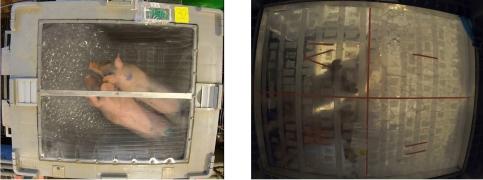Treatments
Each pig was randomy assigned one of six treatments and participated in one test occasion in the foam box study. Treatments were evenly distributed across sex and stratified regarding litter and production batch.
Pigs were placed in the foam box either alone or with a familiar or an unfamiliar companion. Familiar pairs came from the same litter and unfamiliar pairs from two different litters.
The pig(s) were inside of the foam box for a total duration of 7 minutes experienced either the control or the foam treatment:
Control treatment: Pig(s) remain in the empty box without distrurbance.
Foam treatment: Production of an air-filled foam starts after 2 minutes and continues until the bo is full (mean 52.6 s, SD 9.0s). Once the box is full foam production stops. After 10 second pause a air pulse dissolve the foam bubbles.

Behaviour analysis
The pigs' behaviour and vocalisations were video and sound recorded. The behaviour analysis was performed as a blind study. The pigs were observed for a 2 minute observation period that began 30 seconds before the onset of foam production.
All behaviours except for agonistic behaviour were recorded per 10-second interval. Agonistic behaviour were rare and only noted if it occured or not during the test occasion.
Activity - Number of squares crossed with both front hooves.
Escape attempts - Number of escape attempts. Defined as jumping at, pushing against or kicking at the door, walls or roof.
Grunts - Occurence of grunts scored as:
0 = no grunts
1 = a few (≤3) grunts
2 = several (>3) grunts
Squeals and screams - Occurence of squeals and screams scored as:
0 = no queals or screams
1 = a few (≤3) squels
2 = several (>3) squeals and/or screams
Close to companion - Time spent sharing a square with at least one hoof each.
Contact with companion - Time spent in physical contact with the other pig.
Statistics
Activity and time spent close to and in contact with a companion were included in a General Linear Model. Escape attempts, grunts and squeals and screams were expressed as whether the behaviour occured within the interval or not, and these behaviour were included in a Binary Logistic Model.
Both models used the effect of treatment, interval, sex and litter. The difference between the models were 1) that interactions between treatment and interval were included in the General Linear Model, and 2) that the Binary Logistic Model used 30-second intervals instead of the original 10-second intervals.
Responsible for this page:
Director of undergraduate studies Biology
Last updated:
05/27/20
